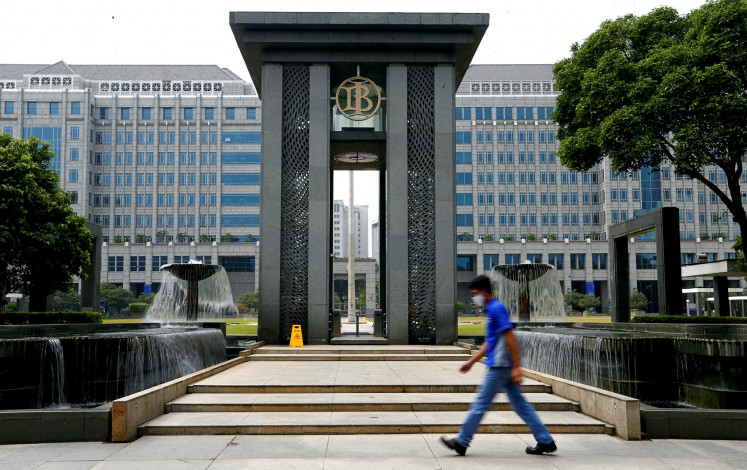Analysis: How powerful is the young Indonesian consumer?
The topline results of the 2010 Census by the central statistic agency BPS have been announced, but the details will take a few more months before they are released
Change text size
Gift Premium Articles
to Anyone

T
he topline results of the 2010 Census by the central statistic agency BPS have been announced, but the details will take a few more months before they are released. We now know that the population
is 237,000,000 people. Because Roy Morgan Research is in the fi eld every week, we also know that there are no sudden or surprising changes since the last census in the fundamental demographics of Indonesia, like age or gender.
The noteworthy changes are in the mind, with opinions, attitudes and behavior in continuous evolution. That’s an area no census nor any demographic study can illuminate. Some attitudes are constant, some opinions waver, some behavioral signs indicate dramatic change in the making. It is by watching these nuances that astute marketers can pick up trends and stay ahead of the competition. But nobody, astute or otherwise, would argue with the fact that Indonesia’s youth of 14 to
24 year-olds constitute a powerful market for just about everything. Some 50 million spread across the country can hardly be ignored. That’s about one in three Indonesians aged 14 years and older. Not only do they have more needs and wants than their parents, they also have more money in their pockets.
In terms of changing trends in shopping behavior, young people are heading in the same direction
as the older generations. But they are pushing those trend lines harder. Like their parents, they too are also visiting pasar and toko less, but they are patronizing convenience stores and supermarkets more than their predecessors. This difference is even more pronounced in the big cities, but also in the towns where the “modern trade” outlets are mushrooming around the country.Not surprisingly, these differences between urban and rural youth are equally noticeable when lifestyle indicators are taken into consideration. While 65 percent of all Indonesians 14–24 years old have a mobile phone today, that number jumps up to 76 percent in the Top 20 cities, levels at 68 in the towns and drops to 58 in the kampungs. It’s important to remember that monthly spend levels are similar, in each of
the three geographies.
The picture is almost reversed when we take a closer look at another indicator, the motorcycle. While
one in three young Indonesians ride one, the number drops to 28 percent in the Top 20 cities, levels at 34 in other urban and rural areas around the country. Looking at the future, it is the towns and villages that offer the greatest potential. This is where the demand for mobile phones and motorcycles are much higher in both absolute numbers as well as percentage of population intending to buy one. After all, less than 25 percent of the population lives in the Top 20 cities where penetration levels
have stabilized over time.
Moving away from big price tags to life’s smaller luxuries, a development in the world of beverages will
catch the attention of many readers. The percentage of young people who consumed a carbonated drink in the last four weeks has dipped rapidly from 59 to 36 percent in just five years. Our young are making wiser choices, opting for water and juices instead. This is equally true of alcoholic beverages, declining from 3 percent of young men to 2 percent in the same period. As for the young ladies,
the percentage who bought lipstick in the last four weeks has gone down from 18 to 12. By now, you have probably jumped to the wrong conclusion as you try to fi gure out what’s going on in their minds.
It’s in the mind where the changes in today’s youth are becoming gradually more visible, in contrast to
those who came before them. Some of these cross-currents may appear to be in conflict, making them harder and harder to comprehend. But when the jigsaw is pieced together with patience, it all makes sense. Like most of their parents, today’s young also believe that “it is important to have a full social life”, but the number agreeing with the statement has slowly declined from 91 percent in June 2006 to 86 in five years. To less and less of today’s young, “it is important to have responsibility in my job”, declining from 77 to 65 percent during the same period. Those of them who believed they “like to be with a crowd of people” also went down from 62 to 57 percent. Similarly, the ranks of those who think “it is important to look stylish” have diminished, from 55 to 52 percent in those five years.
The number of youth who “believe in taking risks” dwindled in time, from 52 to 45 percent today. That revelation goes hand in hand with the shrinking numbers who felt “freedom is more important than the law”. If you had attributed all of this to the growing influence of Islam, you would at best be partially right. The reality is that the number of young Muslims regularly “going to a mosque” is in fact shrinking, down from 71 to 62 percent.. In comparison, the number of young Christians visiting a “formal place of worship” has slipped from 70 to 68 percent during the same period.
It would be a mistake to conclude that a growing number of religious fanatics, introverted and inwardlooking, are gradually removing themselves from society. I believe we are indeed witnessing a rise in spirituality, regardless of religion or place of worship. No wonder, with the symptoms and signs of moral decay on the rise, spreading across politics, bureaucracy and business. Infl uenced by what they are painfully aware of, a better educated, more conservative, more socially and environmentally conscious youth are confi dently making wiser choices across the gamut of challenges that everyday life is throwing at them. For the marketers of today, that means treating young consumers with greater respect than they perhaps received when they themselves were of that age. The respect for their intelligence will translate into better market shares, better returns. These observations are based on Roy Morgan Research. In Indonesia, it is the country’s largest syndicated survey with over 25,000 respondents annually, projected to reflect 90 percent of the population over the age of 14.
The writer can be contacted at debnath.guharoy@roymorgan.com









